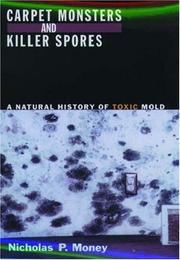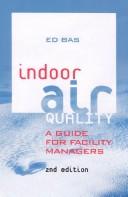| Listing 1 - 10 of 41 | << page >> |
Sort by
|
Book
Year: 2004 Publisher: Bruxelles: UCL,
Abstract | Keywords | Export | Availability | Bookmark
 Loading...
Loading...Choose an application
- Reference Manager
- EndNote
- RefWorks (Direct export to RefWorks)
Introduction. Le tractus respiratoire constitue la cible privilégiée des polluants atmosphériques. Plusieurs études récentes suggèrent une morbité et une mortalité cardiovasculaire accrues parmi les personnes âgées présentant une affection cardiaque ou pulmonaire exposées à la pollution. Dans le cadre de ce projet, nous avons testé l’hypothèse qu’une exposition aigüe aux fumées de combustion de diesel (FCD) entraîne des effets délétères extra-pulmonaires (activation de la coagulation, inflammation systémique et lésions endothéliales) pouvant rendant compte de ces observations.
Sujets et méthodes. Quinze sujets âgés sains, 15 sujets âgés présentant une bronchite chronique obstructive et 29 sujets asthmatiques (15 ayant un asthme léger et 14 un asthme modéré) ont p^ris part à l’étude. Les sujets sains ainsi que les bronchiteux chroniques ont été exposés pendant une heure à une concentration déterminée de FCD (PM = 300 ùg/m³) ou à de l’air filtré. Pour les sujets asthmatiques, la concentration en particules était de 100 µg/m³ et la durée d’exposition de 2 heures. Les concentrations plasmatiques des marqueurs d’inflammation (protéine C-réactive, fibrinogène), d’hypercoagulabilité (D-dimères, fragment 1+2 de la prothrombine) et de la fonction endothéliale (activité du facteur de von Willebrand) ont été mesurées à trois temps différents, avant et après exposition. La protéine des cellules de Clara (CC16), un marqueur sensible de l’intégrité de la barrière épithéliale pulmonaire, a été mesurée chez les BPCO et les sujets sains.
Résultats. Les concentrations de base de chaque paramètre étaient normales. Aucune modification significative n’a été observée suite à l’exposition aux FCD par comparaison à celle de l’air au sein de chacun des quatre groupes.
Conclusions Ces résultats ne plaident pas en faveur de l’hypothèse qu’une exposition aigüe aux FCD à des concentrations rencontrées dans l’environnement entraîne une inflammation systémique, une hyper-coagulation sanguine ou des lésions endothéliales chez les sujets à risque telle que les personnes âgées, les sujets bronchiteux et les asthmatiques. D’autres études impliquant des sujets plus sensibles présentant une affection cardiaque, exposés plus longtemps et à d’autres polluants seront nécessaires pour confirmer ces résultats Background. The respiratory tract is regarded as the main target pf air pollutants. Several studies have however shown that exposure to ambient air pollution especially particulate air pollution is associated with increased cardiovascular morbity and mortality, mainly in elderly individuals with pre-existing chronic heart or lung diseases. The mechanisms linking cardiovascular diseases and particulate air pollution remain to be elucidated. In the present study, we have tested the hypothesis that acute exposure to diesel exhaust might result in extra-pulmonary adverse effects including activation of blood coagulation, systemic inflammation and endothelial damage which might account for the cardiovascular morbity of air pollution.
Subjects and methods. The study involved 15 elderly healthy subjects, 15 elderly subjects with COPD and 29 young asthmatics (15 with mild and 15 with moderate asthma). Healthy and COPD subjects were exposed on two separate occasions either to diesel exhaust at a PM concentration of 300 µg/m³ or filtered air for one hour. For asthmatic the PM concentration was 100ùg/m³ and the duration of exposure two hours. Plasma levels of markers of inflammation (ultra-sensitive CRP, fibrinogen), (von Willebrand factor activity) were determined at three time-points: before as well as after exposure. The 16 kDA Clara cell protein, a sensitive marker of the Lung epithelial barrier, was also measured in healthy and COPD subjects.
Findings. The baseline of all parameters were within normal ranges and did not change significantly after diesel exhaust compared to filtered air exposure n any of the four groups.Conclusions. These findings do not support the hypothesis that short-term exposure to diesel exhaust at environmentally relevant levels induces systemic inflammation, endothelial damage or blood hyper-coagulability in susceptible individuals i.e. elderly, COPD and asthmatics as estimated by the assay in blood of sensitive bio-markers. Whether observations are applicable are to more susceptible groups of patients with cardiovascular diseases exposed for longer duration and other pollutants remains to be clarified
Book
Abstract | Keywords | Export | Availability | Bookmark
 Loading...
Loading...Choose an application
- Reference Manager
- EndNote
- RefWorks (Direct export to RefWorks)
"In this paper the authors investigate individuals' exposure to indoor air pollution. Using new survey data from Bangladesh, they analyze exposure at two levels--differences within households attributable to family roles, and differences across households attributable to income and education. Within households, they relate individuals' exposure to pollution in different locations during their daily round of activity. The authors find high levels of exposure for children and adolescents of both sexes, with particularly serious exposure for children under 5. Among prime-age adults, they find that men have half the exposure of women (whose exposure is similar to that of children and adolescents). They also find that elderly men have significantly lower exposure than elderly women. Across households, they draw on results from their previous paper (Dasgupta and others, 2004), which relate pollution variation across households to choices of cooking fuel, cooking locations, construction materials, and ventilation practices. They find that these choices are significantly affected by family income and adult education levels (particularly for women). Overall, the authors find that the poorest, least-educated households have twice the pollution levels of relatively high-income households with highly-educated adults. For children in a typical household, pollution exposure can be halved by adopting two simple measures--increasing their outdoor time from 3 to 5 or 6 hours a day, and concentrating outdoor time during peak cooking periods. The authors recognize that weather and other factors may intervene occasionally, and that child supervision outdoors may be difficult for some households. However, the potential benefits are so great that neighbors might well agree to pool outdoor supervision once they became aware of the implications for their children's health. This paper--a product of the Infrastructure and Environment Team, Development Research Group--is part of a larger effort in the group to study environmental health issues in developing countries"--World Bank web site.
Book
Abstract | Keywords | Export | Availability | Bookmark
 Loading...
Loading...Choose an application
- Reference Manager
- EndNote
- RefWorks (Direct export to RefWorks)
"Indoor air pollution (IAP) from cooking and heating is estimated to kill a million children annually in developing countries. To promote a better understanding of IAP, the authors investigate the determinants of IAP in Bangladesh using the latest air monitoring technology and a national household survey. The study concludes that IAP is dangerously high for many poor families in Bangladesh. Concentrations of respirable airborne particulates(PM10) 300 ug/m3 or greater are common in the sample, implying widespread exposure to a serious health hazard. Poor households in Bangladesh depend heavily on wood, dung, and other biomass fuels. The econometric results indicate that fuel choice significantly affects indoor pollution levels: Natural gas and kerosene are significantly cleaner than biomass fuels. However, household-specific factors apparently matter more than fuel choice in determining PM10 concentrations. In some biomass-burning households, concentrations are scarcely higher than in households that use natural gas. The results suggest that cross-household variation is strongly affected by structural arrangements cooking locations, construction materials, and ventilation practices. The authors' analysis also suggests that poor families may not have to wait for clean fuels or clean stoves to enjoy significantly cleaner air. Within their sample household population, some arrangements are already producing relatively clean conditions, even when "dirty" biomass fuels are used. Since these arrangements are already within the means of poor families, the scope for cost-effective improvements may be larger than is commonly believed. This paper--a product of the Infrastructure and Environment Team, Development Research Group--is part of a larger effort in the group to identify appropriate policies for the improvement of environmental quality"--World Bank web site.
Indoor air pollution --- Poor --- Ventilation
Book
ISBN: 9703601995 Year: 2004 Publisher: México, D.F. Instituto Politécnico Nacional
Abstract | Keywords | Export | Availability | Bookmark
 Loading...
Loading...Choose an application
- Reference Manager
- EndNote
- RefWorks (Direct export to RefWorks)
Article
Year: 2004 Publisher: [S.l.] : [s.n.],
Abstract | Keywords | Export | Availability | Bookmark
 Loading...
Loading...Choose an application
- Reference Manager
- EndNote
- RefWorks (Direct export to RefWorks)
air pollution --- air pollution --- Smell --- Smell --- pollution control --- pollution control --- Piggeries --- Piggeries

ISBN: 0195172272 Year: 2004 Publisher: Oxford New York : Oxford University press,
Abstract | Keywords | Export | Availability | Bookmark
 Loading...
Loading...Choose an application
- Reference Manager
- EndNote
- RefWorks (Direct export to RefWorks)
Molds --- Molds --- Indoor air pollution --- Control --- Health aspects --- Molds --- Molds --- Indoor air pollution --- Control --- Health aspects
Book
ISBN: 9197369179 Year: 2004 Publisher: Göteborg The Swedish NGO Secretariat on Acid Rain
Abstract | Keywords | Export | Availability | Bookmark
 Loading...
Loading...Choose an application
- Reference Manager
- EndNote
- RefWorks (Direct export to RefWorks)
This book is about a few hundredths of a percent of the air we breathe - for that is the total extent of what we call air pollution. Even so, the effects on people and nature are very tangible: the climate is changing, rare species of animals and plants are under threat, lakes are becoming acidified, buildings are eroding, and so on. The nature of these air pollutants, where they come from, what effects they have, and what can and is being done to tackle the problems, are described and discussed in depth, as well as the fact that it is actually profitable to reduce emissions. Much space is given to highlighting the important but often overlooked links that exist between problems that are usually considered individually, both with regard to their effects and their causes and remedies. (Bron: covertekst)
Air pollution. Air purification --- Environmental Sciences and Forestry. Environmental Management --- Environmental Pollution --- Air Pollution --- Luchtvervuiling --- 614.623 --- 041484.jpg --- Luchtverontreiniging --- Air Pollution.
Book
ISBN: 9291676357 Year: 2004 Volume: 4/2003. Publisher: Luxembourg Office for Official Publications of the European Communities
Abstract | Keywords | Export | Availability | Bookmark
 Loading...
Loading...Choose an application
- Reference Manager
- EndNote
- RefWorks (Direct export to RefWorks)
Air pollution. Air purification --- European Union --- Air --- Pollution

ISBN: 1680159976 0881734659 9780881734652 0824757688 9780824757687 9781680159974 088173327X 9780881733273 9780203913178 0203913175 088173327X 9780881733273 0824740092 9780824740092 9781003151074 1003151078 9781000354393 1000354393 9788770222365 8770222363 9781000355505 1000355500 Year: 2004 Publisher: [Place of publication not identified] Fairmont Press Incorporated
Abstract | Keywords | Export | Availability | Bookmark
 Loading...
Loading...Choose an application
- Reference Manager
- EndNote
- RefWorks (Direct export to RefWorks)
This guide provides a comprehensive account of indoor air quality hazards, their sources, and appropriate solutions. Written in easy-to-understand, non-technical terms, it is designed to be used as both a ready reference and a training guide for facility managers. Each specific type of indoor air hazard is addressed, including allergens, asbestos, formaldehyde and VOCs, radon, tobacco smoke, legionellosis and related illnesses, carbon monoxide, multiple chemical sensitivity, and toxic mold. The basics of proper ventilation and the relationship of the HVAC system to indoor air quality are fully explained. Fundamental procedures for maintaining good air quality, including filtration, control of humidity and moisture, and duct cleaning are examined in detail. A full chapter is devoted to recent developments and procedures for controlling toxic mold. Case studies are also included.
Indoor air pollution. --- Air --- Sick building syndrome --- Pollution, Indoor --- Pollution
Digital
Year: 2004 Publisher: Oxford
Abstract | Keywords | Export | Availability | Bookmark
 Loading...
Loading...Choose an application
- Reference Manager
- EndNote
- RefWorks (Direct export to RefWorks)
Industrial economics --- Air pollution. Air purification --- United Kingdom
| Listing 1 - 10 of 41 | << page >> |
Sort by
|

 Search
Search Feedback
Feedback About
About Help
Help News
News